|
Back when martial arts cinema first exploded in the UK, I was lying my way into see these films by dressing up, standing tall, and badly faking an 18-year-old's cocky self-assurance, and soon became starry-eyed at a genre that seemed to exist solely to make my teenage years more tolerable. Among the titles that had a particular impact on me were Chang-hwa Jeong's 1972 King Boxer (aka The Five Fingers of Death) – the first kung-fu film that I and many others saw – absolutely everything in which Bruce Lee appeared, and a 1972 film titled Hapkido. This one was a bit of a revelation for me and my fellow genre fans for one simple reason – it was the first martial arts film we'd seen that featured a female lead. And she was dynamite. At least that's what we thought at the time. We were 14 years old, for pity's sake, and Angela Mao was both beautiful and deadly. To us she was Emma Peel crossed with Bruce Lee and we all fell in love.
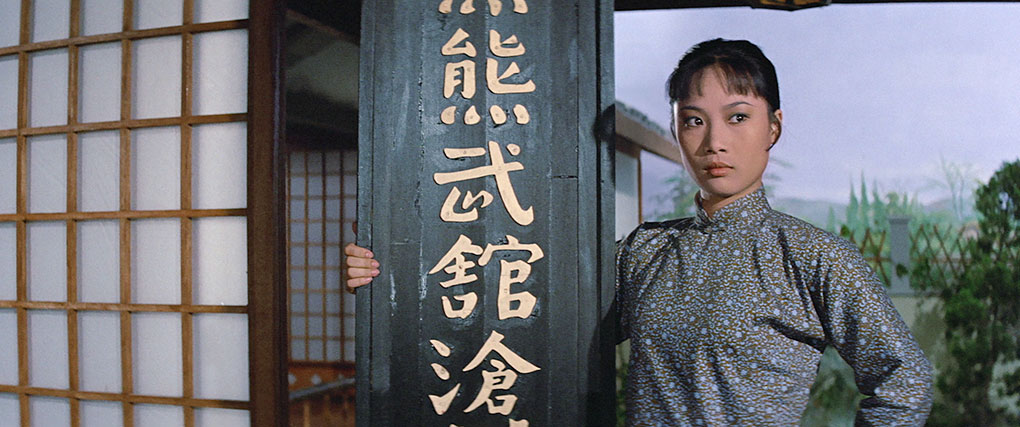
Back then, we had no idea just how many martial arts movies were being made in Hong Kong, as only a small trickle of them reached provincial British cinemas. I made a point of seeing everything that came my way, but the only other film that screened locally in which Mao appeared was Enter the Dragon, and she unfortunately wasn’t in that one for long. And so the years passed, and Hapkido became a distant memory until 2006 and its release on UK DVD by Hong Kong Legends in a new restoration. I genuinely couldn’t wait to see it again, and when I did I… well, I’ll get to that below in the part of this review that has been updated from my coverage of that early Hong Kong Legends DVD release. And now, thanks to Eureka’s heroic efforts to further restore these classic martial arts movies and release them on Blu-ray, we have not just Hapkido, but its immediate predecessor, Lady Whirlwind. Story and character-wise, the two are not connected, but both were directed in 1972 by Huang Feng (who also helmed Angela Mao’s 1971 debut feature, The Angry River [Gui nu chuan]), and the action was choreographed in each by that giant of Hong Kong martial arts cinema, Sammo Hung, who also plays key supporting roles in both films.
There is a sense that Hapkido is the headline title in this two-disc package – it is, after all, listed first on the cover and I fully understand why – and I did get the impression from comments made in the special features that the commentaries for that film were recorded before those for Lady Whirlwind. That said, I have elected to cover them in chronological order and would suggest viewing them that way, as much of what makes Lady Whirlwind a great action film is taken to another level in Hapkido. But first...
| LADY WHIRLWIND [TIE ZHANG XUAN FENG TUI] (1972) |
|
Seemingly taking its cue from the title, the 1972 Lady Whirlwind (released in the US as Deep Thrust, if you please) wastes no time in setting up its plot and establishing its action credentials. A young woman named Shuang-shuang (Oh Kyung-Ah) is walking down a woodland path when she sees a man named Ling Shih-hao (Chang Yu) taking a beating from his fellow gang members for refusing to transport drugs, a process overseen by their Chinese-named Japanese boss, Tung Ku (Pai Ying). Shih-hao fights gamely but is ultimately beaten down and left for dead, and after his assailants depart, Shuang-shuang walks over to his body, and the enchantingly primitive title sequence unfolds.
The action then shifts to the busy Tai Hsing casino, into which walks Tien Li-Chun (Angela Mao) wearing a look of grim determination. Using an unexplained technique that borders on the magical, she repeatedly wins at dice and quickly amasses a sizeable pot. When she attempts to pack her winnings away, however, she is accosted by casino enforcer Tiao Hung (Sammo Hung), whom she casually slaps hard enough to send him into a neatly executed backward headspring. She then offers to return the money to the gangsters that run the casino if they hand the aforementioned Ling Shih-hao over to her. A surprised Hung refuses, and Li-Chun responds with the ominous warning, “You’re forcing me to get rough with you!” Think she’s kidding? Just you wait.
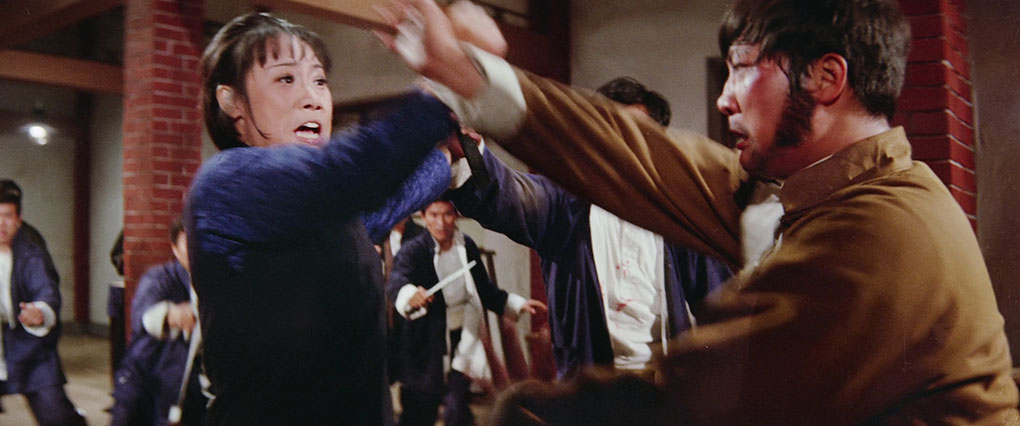
A fight breaks out that pits Li-Chun against a sizeable collection of casino goons, and it’s an absolute blast. Choreographed by Sammo Hung, it serves as an early reminder of what made these old-school kung fu movies so thrilling to watch, with punches and kicks executed with speed, style and unbroken fluidity as the fight drifts around the casino and furniture is mounted, swung and broken, and knife-wielding bad guys are quickly disabled. The battered and bruised goons eventually flee, but just as it looks as though the fight has concluded, Li-Chun steps outside and the whole thing kicks off again. After kicking and punching her assailants silly, Li-Hung brings the fight to a close by battering Hung around the face with a bag of her winnings, leaving him to report his failings to Tung Ku and female gang boss, Tiao Ta Niang (Liu Ah-Na). In that manner classic kung-fu movies had of unsubtly painting characters as either morally pure or unspeakably evil, both Tung Ku and Tiao Ta Nang are instantly identified as bad because they’re smugly smoking cigarettes in long cigarette holders,* and Ku is constantly rolling those metal kung fu balls that only seemed to be favoured by martial arts movie villains.
Tiao is seriously pissed off at Hung for allowing himself to be beaten by a woman and orders her men to take him outside and kill him, a particularly harsh enforcement of their code of conduct given that Hung is her younger brother. Ku intervenes, suggesting they hold off until they’ve got the true measure of this mysterious woman’s skills, and sends a posse of men out to find and apprehend her. It doesn’t go well. First they mistake a dining Shuang-shuang for Li-Chun, then when she stands up to their aggressive questioning, an almost comic-book Japanese ronin named Ichiro Fumita (Chien Yueh Seng) steps in and smacks them up for assaulting a woman. When Ku arrives with reinforcements, it turns out that Fumita is Ku’s younger brother and thus on the gang’s side after all. Crucially, Li-Chun is secretly watching all of this from an upstairs landing, and is shocked when she hears Shuang-shuang’s angry proclamation that Ling Shih-hao is dead. Except he’s not. Despite looking genuinely lifeless when we last saw him (he was sprawled on the ground with his eyes wide open and unblinking), he apparently survived the beating and was nursed back to health by the now devoted Shuang-shuang. He’s currently training himself up to take revenge on the gang that tried to kill him, a plan that is complicated when Li-Chun discovers that he is still alive, as she has been planning to kill him as revenge for him abandoning her sister, who was left so distraught that she took her own life.
As the above hopefully indicates, Lady Whirlwind has a more developed story than many of its compatriots, and while its prime purpose is still to move the characters from one fight to the next, this adds a level of personal conflict and complexity to a situation that is otherwise painted in traditionally black and white terms. The bad guys are as ruthless and morally monstrous as ever, but of the three protagonists, only Shuang-shuang is as pure as the driven snow. Shih-hao wants to rid the district of every trace of Tiao’s gang, presumably by killing them all, and Li-chun is uninterested in assisting with this lofty ambition and instead seems determined to impede it by killing Shih-hao to avenge her sister’s death. This does tend to make Li-chun the most interesting of the three characters, as she pops up at the most inconvenient moments and has to be repeatedly persuaded by Shih-hao or Shuang-shuang to pause her quest for vengeance for just long enough for Shih-hao to have another go at his.
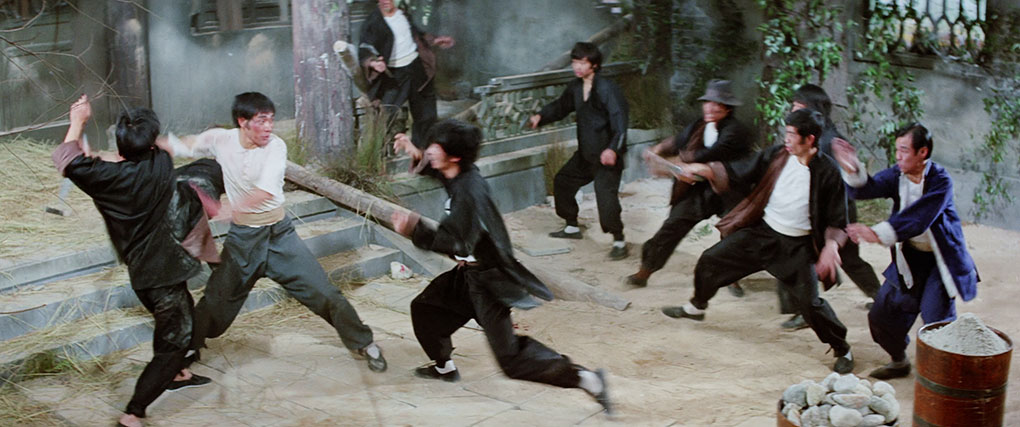
In other respects, the film plays by the old-school kung-fu rule book, and no fans of these movies will have a problem with that. Shih-hao may have trained hard and be deadly with his fists and feet, but he hasn’t reckoned on the advanced karate skills of Ichiro Fumita, the traditional secret weapon wheeled out to do what the Tiao gang fighters are incapable of achieving. Later – in a side story that seems to take place in an alternative timeline, where weeks spent by Shih-hao pass as hours for the rest of the characters – Shi-hao encounters a Korean medical sage who is dying of a snakebite but just happens to be carrying an instruction manual for a particularly deadly form of Tai Chi. This allows Shih-hao to beef up his skills to a level where he can – in the film’s most thrilling choreographed fight – do battle with the deadly Tung Ku, Fumita having by then been soundly dealt with by Li-chun.
It’s a hugely entertaining tale whose action is fabulously choreographed and performed, though at this stage Sammo’s skills as a fight arranger and sequence director had not quite hit the heights they would with Hapkido later the same year. It’s also noted on the commentary tracks that unlike the most of the martial arts films that followed, the camera was not slightly undercranked here and the action was thus recorded at its natural speed, which frankly gave me even more respect for the skills of the performers. Either way, Lady Whirlwind is still a blistering martial arts movie with an unexpectedly captivating and morally twisty story. Mao may not have initially been top billed here, but it’s ultimately her movie, and it helped lay the groundwork for what for one of the finest action movies of the decade, which of course was…
| HAPKIDO [HE QI DAO] (1972) |
|
When I first revisited Hapkido on DVD in 2006, many years had passed since I had seen it on the big screen. By this point it had become little more than a memory of a happy time spent in the cinema, one boosted by the small thrill that I was legally too young to be in there in the first place. Recalling anything about the plot or other details was nigh-on impossible all so much later, beyond the conviction that the fights had been great and there was some serious trampoline-assisted leaping at one point. It was thus hard to describe how excited I was when Hong Kong Legends announced that it had restored the film for UK DVD release, although my enthusiasm was tinged by just a touch of apprehension. As I said, it had been a long time since my first and only viewing, and I back then I had an adolescent boy's crush on its female star. After all those years and all the movies I'd seen since, would it live up to my expectations? Believe it or not, it actually surpassed them, and revisiting the film again on Eureka’s superb new Blu-ray set has done nothing to dent that original impression.
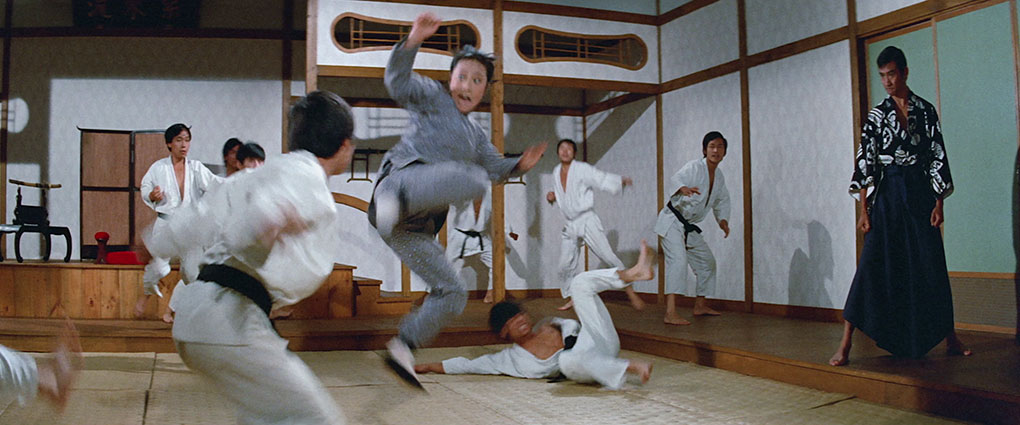
Before I move on, there is one aspect of the film that has not aged so comfortably, but that has to be viewed in the context of the time and the country in which it was made. As with Jimmy Wang Yu’s genre-shaping 1970 The Chinese Boxer [Long hu dou] and a good many Hong Kong martial arts movies since (Lady Whirlwind included), the decent, good-hearted protagonists here are Chinese, and the unspeakably nasty bad guys are Japanese and the film wastes no time in painting them as monsters. But Hapkido is set in 1934, and as it begins, our three Chinese lead characters – Yu Ying (Angela Mao), Kao Chang (Carter Wong, making his feature debut here) and Fan Wei (Sammo Hung) – are in Japanese occupied South Korea to study hapkido. As Frank Djeng reminds us on his commentary tracks, during that time, young (and we’re talking sometimes early teen young) Korean females were taken from their homes by the occupying soldiers to work as sex slaves for the Japanese army, and on this film’s release, many of those watching would still have strong memories of both this and Japan’s invasion of China during the Second Sino-Japanese war. For the local audience of the day, casting the Japanese as the bad guys was on a par with having Germans as the villains in a Western war movie. It’s something you have to live with in early 70s kung fu movies, and if you can set this aspect aside – and even as a committed Japanophile, I’ve long ago learned to do so – in the areas that count, Hapkido is an absolute belter.
Having loudly established the Japanese as the villains in the opening scene, the charmingly dated graphics of the action-packed opening titles dovetail into a string of sequences whose primary purpose is to introduce the audience to hapkido. For those who do not know, this is a Korean martial art whose fifty year evolution – principally under the direction of Yong Sul Choi – was not actually given a name until 1957, and was shaped into the fighting technique recognised today by Master Ji Han-Jae. While I doubt many of those sitting down to watch a martial arts movies are doing so for a history lesson, Hapkido's first ace-in-the-hole is that the Korean master from whom our Chinese students are learning their skills is none other than Ji Han-Jae himself. Thus, when he demonstrates just how the hapkido moves should be executed, he does so with absolute authority and thrilling skill.
Once back in Hong Kong, the three students establish their own hapkido school and in line with tradition set out individually to introduce themselves to the masters of the other martial arts schools in the district. This initially goes well enough, but wouldn't you know it, there's a problem in the shape of the Japanese-run Black Bear School, whose students' ability to fight energetically even when falling-down drunk is actually rather impressive. Even before any official introductions have been attempted here, the hot-headed Fan Wei gives two of them a sound seeing-to after they refuse to pay a restaurant bill and sexually harass a young female customer. The fight itself is brutal and brilliant, and instantly establishes just how far Sammo Hung had progressed as an action choreographer in just one film – the moves are sharply executed and precise, and the camera always perfectly angled to showcase the impact of a hit or disguise its real-world lack of contact.
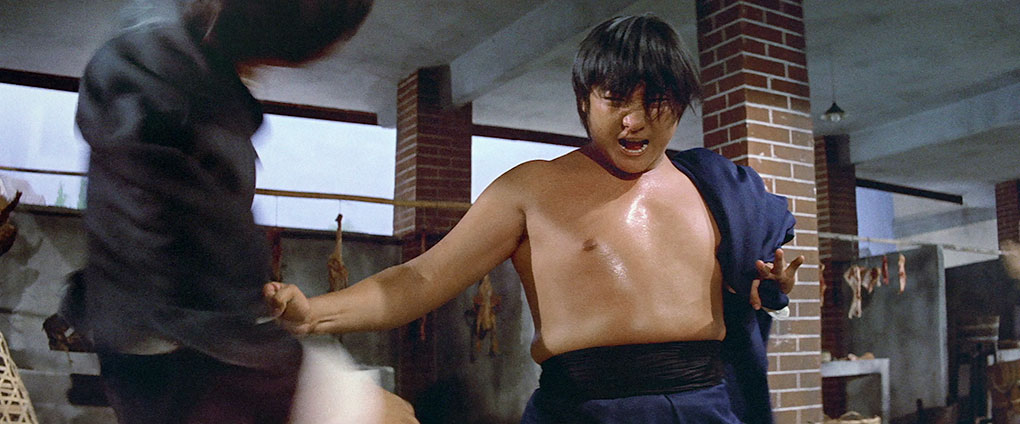
Things for the new school go downhill from here in a manner that will surprise few fans of the genre, as a tit-for-tat battle between the dynamic trio and the Black Bear School unfolds, in the process increasing the film’s similarities to the same year’s Fist of Fury, which danced in the same arena in similar fashion. But let's be honest, you didn’t come for the story, you came for the action, and here's where Hapkido absolutely soars. I would suggest that the comparisons with Fist of Fury extend beyond plot details and the joint year of their release to include the fight choreography and martial arts skills of the stars, and even a couple of distinctive camera placement choices. All three of the leads are onscreen dynamite here, none more so that the fabulous Mao, who proves every bit as explosive as I had remembered – this is someone who could execute four high speed and perfectly aimed roundhouse kicks in rapid succession without missing a beat. This is first generation movie martial arts at its most awe-inspiring, with a series of blistering battles created in the fight choreography and performance rather than the editing suite, with wide and mid shots used to showcase the skills of the performers, which alternate with mobile hand-held camerawork that places us in the centre of the action and matches its energy, a style also employed by but further developed from Lady Whirlwind. Even the earlier film’s use of slow motion has been refined here to really show off the agility, elegance and power of some of the moves. That said, the breakneck pace (no pun intended) of the action does mean that you'll have to look fast for brief early appearances by future genre stars Yeun Biao and Jackie Chan.
In terms of its direction, its fight choreography and the furious performance of its action, Hapkido is a step up from the already high bar set by Lady Whirlwind and a most worthy companion to Fist of Fury, fully deserving to be held in similarly high regard. This remains for me perhaps the finest showcase for Angela Mao’s blistering skills as a martial artist, and marks the point where Sammo Hung’s already impressive fight choreography moved onto a different plane. For my money, this really is as good as it got, an action masterpiece that showcases old-school cinematic martial arts at its very best.
Presented on two Blu-ray discs, the 1080p 2.39:1 transfers from new 2K restorations of Lady Whirlwind and Hapkido both look spectacular here, with gorgeously rendered contrast and colour and the sort of crisp definition of detail that leaves the earlier Hong Kong Legends DVD of the later film in the dust, and that was no slouch for its day. Dirt and damage have all but been eliminated and a fine film grain is visible throughout. Seriously, the films look amazing here.
One thing worth noting about the transfers is that a small number of shots are visibly soft (often at the close-up end of zooms), and one shot in Lady Whirlwind is completely out of focus. This is not a fault of the restoration or the source material, but apparently the result of the fast shooting schedule in Hong Kong cinema of the day, where shots were completed, and the crew would move on to the next setup or location without waiting for the rushes from the previous shoot to be processed and returned. If a shot was out of focus and a reshoot impractical, the filmmakers would either dump it at the editing stage or live with it for the brief amount of time it appears on screen. This whole issue is further discussed by Frank Djeng on the commentaries for Lady Whirlwind.
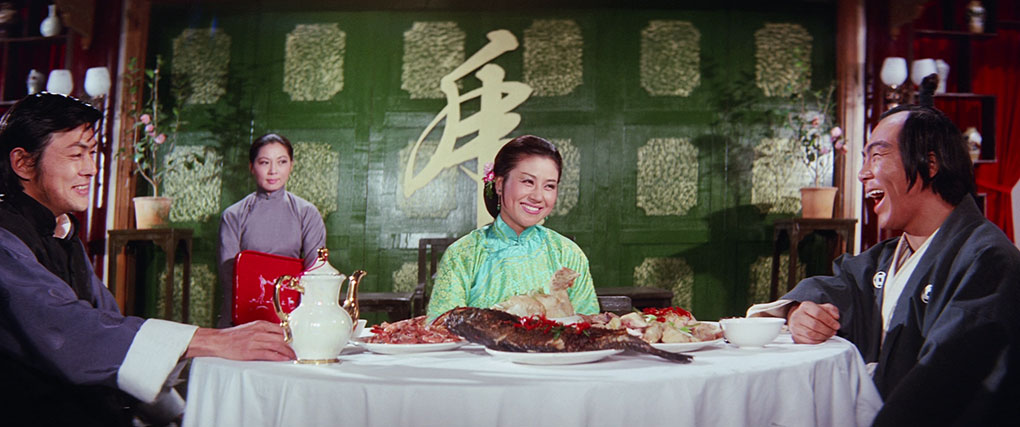
Early 70s martial arts movies tended to be shot silent with dialogue and sound effects added in post-production, allowing for Mandarin, Cantonese, English and other language tracks to be easily added for wider distribution. For reasons once again discussed by Frank Djeng in his commentary tracks, Hong Kong movies of the day tended to have their actors deliver lines in Mandarin, and the Mandarin audio tracks are thus always the best match to the image. As it turns out, there is also another good reason for choosing the Mandarin track, but I’ll get to that in a minute.
On Lady Whirlwind, you can choose between Mandarin mono and English mono, both of which are presented as DTS-HD Master Audio 1.0. The Mandarin track has a narrow dynamic range, with little going on at either the treble or bass end of the audio spectrum, but dialogue is still clear enough and those movement wooshes and whack-on-wood contact blow sounds are still deliver with appropriate force. The English track feels a little louder and clearer, but while this is how we saw these films when they were first released in the UK, those various accented English voices feel all wrong for the characters today. In order to better match the length of the delivered lines, the English dialogue also differs considerably from the Mandarin original (try watching the film with the English audio track and the subtitles for the Mandarin one activated), and Angela Mao here sounds as if she has spent a few years at a select English finishing school. The treble leaning of this track also takes the edge off the contact blow sounds, which have far more bass wallop on the Mandarin track.
Hapkido again features a Mandarin DTS-HD Master Audio 1.0 mono soundtrack, which also has a narrow dynamic range, but it feels a tad clearer than its Lady Whirlwind equivalent, and the contact blows still have the hoped-for sense of exaggerated impact. When it comes to the English track, there are a generous three options, the vintage “kung fu” dub and the vintage “hapkido” dub, both of which are DTS-HD Master Audio 1.0 mono, and a revised dub in DTS-HD Master Audio 5.1 surround. I’ve not done a side-by-side comparison, but the voices on the kung fu dub and the hapkido dub appear to be the same, with Angela Mao now transformed into a 70s-era American. The dynamic range on both of these tracks is narrow, and the contact blows once again lack the impact they have on the Mandarin track. Clearer by far is the revised dub, which also has distinct separation for the cleanly reproduced sound effects and dialogue, and again has the actors dubbed by American voice artists. What surprises here is that the contact blows are considerably more subdued than on the Mandarin original, which is particularly disappointing given the potential offered by an LFE bass track. It’s almost as if those mixing this track were aiming for something more realistic, which is fine for a fistfight in a Hollywood thriller but has the effect of watering down one of the genuine pleasures of this classic Hong Kong martial arts movie.
Optional English subtitles are provided for the Mandarin tracks, and these kick in by default if these tracks are selected. On the English language tracks, (optional) subtitles will occasionally appear to translate Chinese or Korean text.
LADY WHIRLWIND
Commentary by Frank Djeng & Bobby Samuels
One of the dynamic duos of martial arts movie Blu-ray commentary is back in the persons of genre expert Frank Djeng and action movie producer, director and martial artist Bobby Samuels, a close friend and colleague of Sammo Hung and the only African American working in Hong Kong kung fu cinema during its golden age. These two are always great together, with their unbridled enthusiasm for these movies matched by their extensive knowledge of the genre, its films and its practitioners, from its stars down to the bit part players. They comment on the spaghetti western feel to the opening scene, the Korean exterior location work, the kung fu balls that were a signature of genre bad guys, why some shots are slightly (and in one case severely) out of focus, the music cues stolen from James Bond movie scores, the lack of foley work for background sound, and much more. Samuels shares some personal memories of Mao, and both men praise her skills and her acting, opining that she could carry a film single-handed. No argument here.
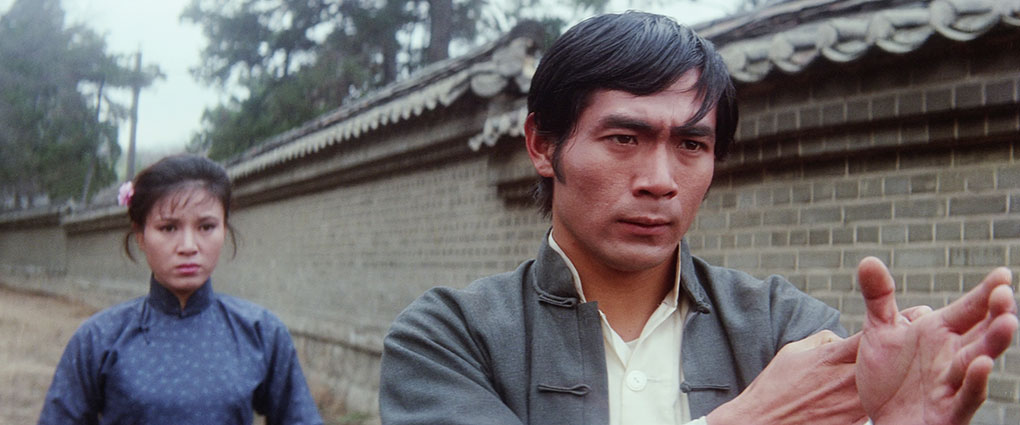
Commentary by Frank Djeng & Michael Worth
I have to admit to initially being a little apprehensive about this second commentary, given that it was again co-hosted by Frank Djeng and thus likely to cover similar ground to its predecessor. Yet while this is true of some elements – Djeng even repeats a couple of comments almost verbatim here – he and actor, martial artist and filmmaker Michael Worth manage to still discuss plenty that is new and revisit previous turf from a different angle. There’s less focus here on personal recollections and more on factual and biographical details, with information on several of the actors, including the leads and a fair few members of the supporting cast. They reveal that the fights are a blend of various martial arts styles, and also that fight choreography was not planned in advance of the shoot, but worked out on the day by fight arranger Sammo Hung. They also note that the filmmakers tended to only shoot the shots they knew they needed, effectively editing in camera to save money. Both men prefer this film over Hapkido for its more developed story, but concur that the action in the later film is definitely superior.
Commentary by Samm Deighan
With just about everything covered to some degree in the first two commentaries, I really did wonder what this third one by writer and film historian Samm Deighan could possibly bring to the table, but once again the good people at Eureka demonstrate clearly that they know what they’re doing. Although there is some inevitable crossover with the previous commentaries, Deighan provides even more biographical detail on the lead actors and some of the supporting players, and expands on the allure of Mao’s screen presence and some of the key tropes of the genre that are in full play here. I should note that I listened to all three commentaries in a row and rarely felt I was being repeatedly told the same thing. Bravo to all concerned.
Lady Whirlwind Speaks with Angela Mao (13:19)
A new interview with Angela Mao, produced by Frank Djeng (how happy I am that Eureka hooked up with this man), filmed in what looks her son Thomas’s restaurant, and conducted in Mandarin, with optional English subtitles that kick on by default. Subjects covered – sometimes briefly, sometimes in more detail – include Mao’s early years in Taiwan, how she met director Huang Feng and got her start in the Hong Kong movie business, director King Hu the popularity of the wuxia genre, her approach to acting, working with Sammo Hung, and more. She selects Hapkido as one of her favourite of her films, and is winningly modest about her fame, being surprised that people still know who she is and is always pleased to meet fans.
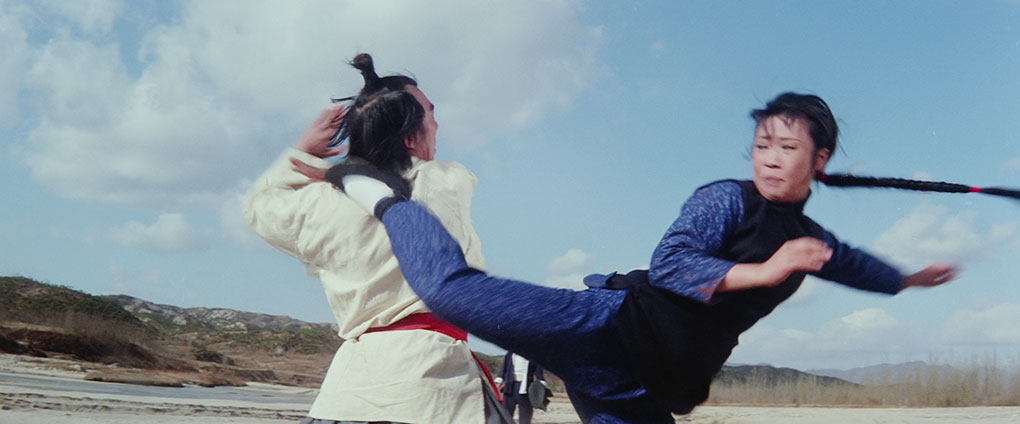
Kung Fu Cooking with Thomas King (31:49)
An interview with Angela Mao’s son, Thomas King, conducted by Frank Djeng (here we get to put a face to the voice) in English in King’s New York restaurant. He reveals that despite learning martial arts from his mother at an early age, he was unaware of her fame as kung fu movie star until he sat down with friends to watch Enter the Dragon, and later when a fans showed up at the restaurant bearing movie memorabilia. He talks about his mother becoming more receptive to the attention her past fame still attracts, and credits a fan named Hector Martinez and his respectful approach with instigating this. He also gives his views on the importance of these Blu-ray restorations of old-school martial arts films, praising them for bringing its first stars to the attention of younger genre devotees. After this, all talk moves onto the family restaurants, how they were started, how they coped with the Covid outbreak, and the cuisine. Djeng emphasises how good the food is and encourages everyone watching to pay King’s restaurant – named The Shack and based in Queens – a visit if they are ever in New York. I’m actually getting hungry just typing this.
Alternate English Credits (1:34)
As the title says. Not much I can add, really.
Trailer Gallery
HK Theatrical Trailer (3:23)
Action galore is overlaid with blood-red captions in Chinese and English that comprise largely of short assurances of content such as “Fatal movements. Heart-piercing kicks,” and the hard-to-dispute, “A gripping story. Hectic action.” Someone is also keeping count here and is thus able to announce that the film has “36 Hapkido hand attacks, 72 Hapkido kicks.” Which of the two films in this set is this a trailer for again?
US Theatrical Trailer (1:55)
The original American trailer, looking a bit faded and worn but still of interest, in part for the stern narrator’s proclamation that our Angela is “Mistress of the death blow, queen of the Deep Thrust,” which should tell you which title this is being marketed under. He also assures us that “It makes judo, karate and kung fu look like child’s play.” Erm…
US Radio Spot (1:01)
An audio version of the above, also advertising the film under the US title of Deep Thrust, with that narrator intermittently pausing for a series of loud shouts and unarmed combat wallops.
Image Gallery
25 screens of middling quality promotional stills, and posters, including several American ones under that steady-on-missus title of Deep Thrust.
HAPKIDO
Commentary by Frank Djeng & Bobby Samuels
Frank Djeng and Bobby Samuels return for another hugely enjoyable and educational commentary, this time for a film whose action scenes they are understandably in awe of. Subjects covered include the music borrowed from other sources, how Sammo Hung’s choreography and camera placement has developed from Lady Whirlwind (camera direction tended to fall under the control of the action choreographer during fight scenes, we are informed), the influence of Fist of Fury, why the dialogue in the films of this period was performed in Mandarin and why this later shifted to Cantonese, and plenty more. As in some of his previous commentaries, Samuels shares memories of his time working and living with Sammo Hung, and both heartily recommend Angela Mao’s Nan Bei Ho restaurant in New York. “The food is good!” Djeng assures us enthusiastically.
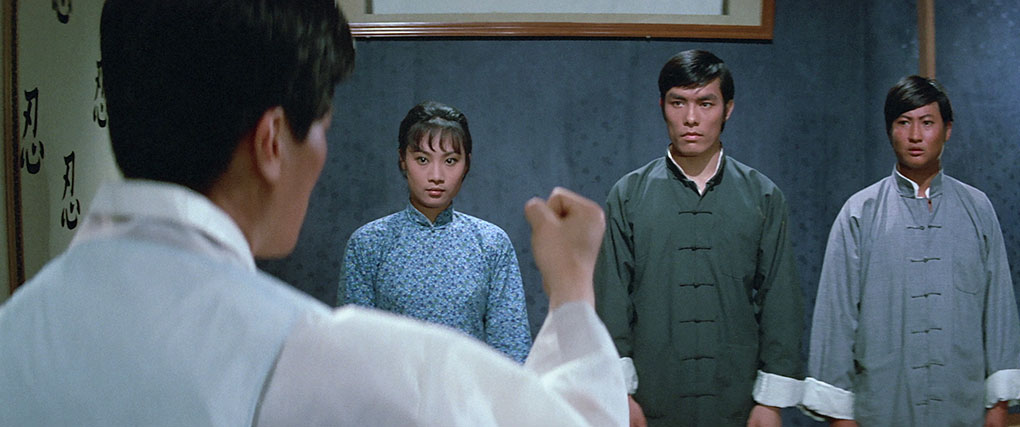
Commentary by Frank Djeng & Michael Worth
Once again, Frank Djeng’s teaming with Michael Worth compliments rather than duplicates his commentary with Bobby Samuels and again proves to be an essential companion to the film. Here the two men go into more detail about the appalling treatment of local women by the Japanese during their occupation of Korea, and how the portrayal of the Japanese in the film would have stirred up patriotic feelings in an audience for whom this would still be an unpleasant memory. Other areas covered include the lead actors, the soon-to-be-more-famous bit part players (who include a very recognisable Jackie Chan), the hapkido martial art and renowned master Ji Han-Jae, the freedom given to the filmmakers by producer Raymond Chow, and more. Both are amazed by this HD restoration, and not for the first time Djeng really pushes the other martial arts titles restored and released on Blu-ray by Eureka. I’m happy to second that.
Lady Kung Fu Speaks with Angela Mao (18:01)
Effectively the second half of the interview on the Lady Whirlwind disc, here Mao talks about the impact of Bruce Lee and thrill of being asked by him to work with him on Enter the Dragon, filming on location in South Korea and learning hapkido, planning and training for the film’s fight sequences, cinematographer Li Yu-Tang and his working relationship with the actors, Sammo Hung making decisions about the fight choreography on the fly, and plenty more. She also reveals that a sequence in which she has execute four rapid roundhouse kicks in a row was shot 52 times. Move over Stanley Kubrick.
Archive Interviews
Angela Mao (16:59)
Interviewed on standard definition low band video in what looks and sounds like a working restaurant, Mao recalls studying hapkido and her Peking Opera schooling, and briefly discusses several of her films, including an injury she sustained on one of them and working with a then young choreographer named Jackie Chan. She also recalls what unfolded when someone was foolish enough to try and rob her. “I don’t think you’d call it a fight,” she assures us. “I prefer kicking. I’m pretty good at kicks.”
Carter Wong (17:01)
Once again filmed in a corner of a busy restaurant and having to verbally do battle with a wall of background noise and even piped music, Carter Wong is interviewed in English by Rainer Czech for what I’m presuming was an earlier DVD release. Topics discussed include learning martial arts, becoming an instructor for the Hong Kong police, meeting Bruce Lee, and working in Hollywood on films like Year of the Dragon, Big Trouble in Little China and Rambo III. He does briefly touch on making his feature film debut with Hapkido, but spends far more time discussing the films he made director Joseph Kuo, going into great detail about his work on The 18 Bronzemen [Shao Lin Si shi ba tong ren]. I can’t help suspecting that this was the film this interview was originally recorded to accompany.
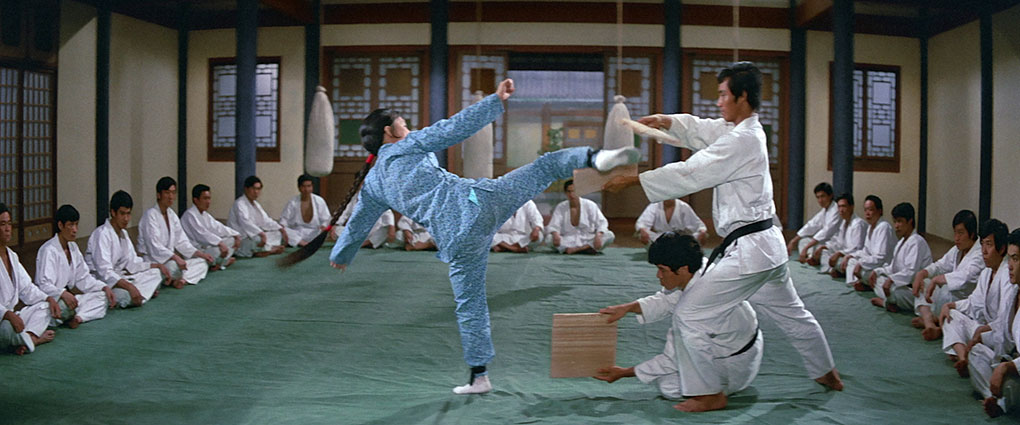
Sammo Hung & Yuen Biao (9:21)
Intercut VHS quality interviews with Sammo Hung and Yeun Biao, which again may have been originally been a special feature on an earlier DVD, presumably for a film in which the two men co-starred. Both talk about not liking school and regularly skipping it, which seems to be how they ended up enrolled in the Peking Opera, and while Biao talks about his skill for choreographing fights in small spaces, Hung notes that he enjoys writing, directing and acting, and ponders on the problems that might arise if he worked in Hollywood. Both pick their favourites of their own films, and Biao tells a brief but intriguing story about how as kids, he, Hung and Jackie Chan got into a fight over 20 cents. “Of course, Sammo won the fight,” he smilingly reveals.
Original Vintage Featurette (6:40)
A short film produced by Golden Harvest in 1972 to promote the release of Hapkido that shows hapkido master Ji Han-Jae instructing a class that includes Angela Mao, Sammo Hung and Carter Wong, who are observed training, breaking wood blocks and being awarded their black belts.
Alternate Opening Credits
Textless Opening (1:32)
With most films this would not be a big deal, but given that the title sequence of Hapkido plays out over a furious martial arts training session, the opportunity to watch it without the title graphics is most welcome.
Hapkido (English) (1:44)
Likely the opening titles of the British release – certainly this was what the film was titled when I first saw it.
Lady Kung Fu (1:44)
The opening credits with the US release title of Lady Kung Fu, which while descriptive runs a poor second to Hapkido.
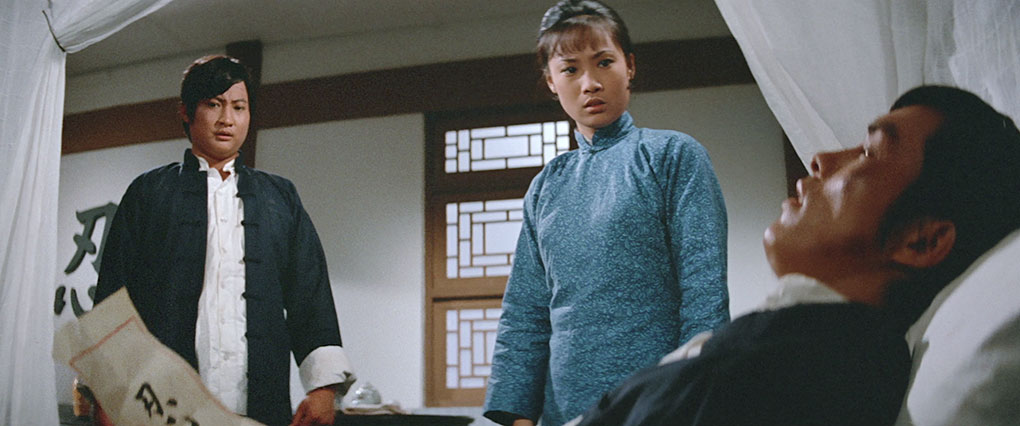
Trailer Gallery
HK Theatrical Trailer (Mandarin) (4:21)
A lengthy and fight-crammed trailer that makes play of its lead actors’ real world martial arts credentials, noting that this is Carter Wong’s debut feature and the only film in which hapkido master Ji Han-Jae has appeared.
HK Theatrical Trailer (English) (4:03)
A similarly explosive trailer whose sometime comical captions assure us that the film will introduce us to “the fightingest [sic] beauty, Angela Mao, the China Moll.”
US Theatrical Trailer (1:33)
Selling the film under its American title of Lady Kung Fu, this trailer also consists of series of fights, but is backed here by a funkadelic score and a narrator who mixes up his martial arts with lines like, “Lady Kung Fu. She’s the crack karate queen who really drives men mad.” He also describes the title character as, “the unbreakable China doll who gives you the licking of your life.” Excuse me?
US TV Spot (0:58)
A shorter version of the above, complete with the above-quoted lines from the narrator.
Image Gallery
66 screens featuring promotional stills, colourised lobby cards, posters, and many scans of pages from what looks like a Hong Kong press book that focus on the hapkido martial art.
Also included with the first 2000 copies of the release is Limited Edition Collector's Booklet featuring new writing by James Oliver, but this was not available for review.
What can I say? Two first generation martial arts movie classics in which the genre’s first female lead is joined by an impressive a roster of soon-to-be-famous co-stars and supporting players. Both films are terrific, but for blinding fight choreography and its blistering performance, Hapkido really is hard to beat. This is a glorious package featuring superb restorations of the two movies, five commentary tracks, and host of other fine special features. For fans of old-school martial arts movies, this is another dream come true. Very highly recommended.
* It was director Jim Jarmusch in his cameo in Wayne Wang and Paul Auster’s Blue in the Face who I first remember noting that the most evil movie villains always seem to smoke cigarettes in unusual ways.
|